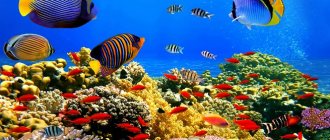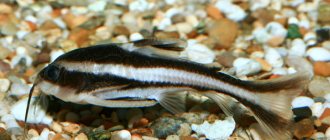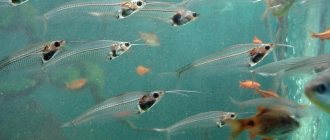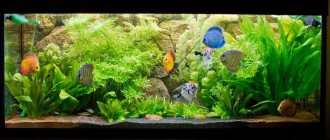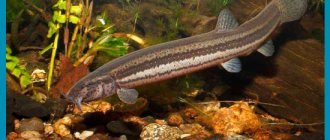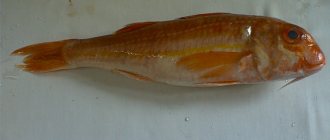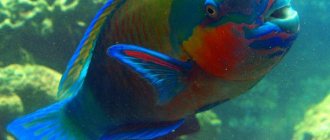The Red Sea, one of the saltiest seas in the world, is very rich in diverse fauna. About 1.5 thousand species of fish that live in this sea have been studied. The diverse fauna attracts tourists from all over the world. By looking at photos of Red Sea fish, you can be convinced of the diversity of the inhabitants of the sea.
This article tells you which fish in the Red Sea can be dangerous to humans. Listed below are the main varieties of Red Sea fish with photos and names that can be found along the entire Red Sea coast.
Parrot fish
The fish's jaw resembles a parrot's beak and its bright colors combine yellow, orange, red and blue. The fish is not predatory, but you should not tease it, since the jaws are quite massive and the bite of such a fish can be very painful.
Napoleon fish
The growth above the eyes resembles the triangular hat of Emperor Napoleon, hence the nickname of the fish. It is not shy towards humans and does not pose a danger. Can swim very close, showing curiosity.
Diagram. Classification of corals and their feeding methods.
In the diagram, the group of photosynthetic corals includes both autotrophics (feeding primarily on zooxanthellae) and mixotrophics (feeding equally on zooxanthellae and the external environment).
There is also a division of corals according to their ability to form reefs into hermatypic (reef-forming) and agermatypic (non-reef-forming). Hermatypic species include Scleractinia, which contains zooxanthellae. Deep Scleractinians that do not contain zooxanthellae are agermatypic.
Imperial angel
The imperial angel is a very beautiful fish that inhabits coral reefs. The color is blue or dark blue with alternating yellow and white stripes of different shapes. It reaches a length of up to 40 cm. Such fish are often kept in aquariums. Fish does not pose a danger to humans.
Coral reefs
Coral reefs are one of the most mysterious ecosystems on the planet and are home to a quarter of marine fish species.
Corals can only live in tropical or subtropical zones. In the Red Sea, the warmest in the world, unique conditions have been created for the development of about 250 species of corals, forming reefs of diverse textures, colors, and sizes. Colonies stretch for many kilometers along the coast of Egypt, becoming the basis for the livelihoods of hundreds of species of underwater fauna.
Corals are marine animals, representatives of the most primitive ancient groups of living beings on the planet. Their peculiarity is that after their death, the remaining calcareous skeletons contribute to the formation of reefs.
Rainbow colors, exotic inhabitants, sunken ships and mysterious caves of the reefs of Hurghada and Sharm el-Sheikh attract tourists - divers from all continents.
When making underwater trips, you need to have at least a little knowledge about the rules of communication with the beauties of the sea, the fish of the Red Sea - many of them, although safe in appearance, can cause trouble for an overly curious person.
Fish stone
This fish lives on the bottom, camouflaging itself well as aquatic soil, and also blends well with the surrounding landscape, resembling stones. You can simply not notice it. This fish has spines with poison on its back.
Look - Rotan fish - features of the fish, description of the structure, habitat and methods of fishing (video + 100 photos)
When injecting such a fish, medical assistance must be provided no later than three hours after the injury, since the poison of this fish is very strong and death occurs as a result. The stone fish (wart) is considered the most poisonous in the world.
Autotrophic nutrition
Symbiotic algae receive inorganic compounds from the coral and the environment (carbon dioxide, bicarbonates, ammonium, nitrates, phosphates) and process them through the process of photosynthesis into organic molecules such as glucose, glycerol, fatty acids, amino acids, which are food for the coral , and for the zooxanthellae themselves. Nitrogen-fixing cyanobacteria also participate in the process of photosynthesis, supplying ammonia, which they produce from dissolved nitrogen. Those. Nutrients are exchanged between corals, zooxanthellae and bacteria.
Photos of red sea fish
Types of food and feeding of various corals
Soft corals Alcyonaria (photosynthetics).
They contain zooxanthellae, which through photosynthesis provide food for the coral. Excess zooxanthellae can also serve as food, entering the intestinal cavity and being digested. Corals can feed heterotrophically, consuming phytoplankton as well as dissolved organic matter. Popular Alcyonaria (photosynthetics) include: Cladiella, Clavularia, Cornularia, Lemnalia, Lobophytum, Sarcophyton, Sinularia, Tubipora musica, Xenia. When kept in an aquarium, in addition to feeding with zooxanthellae, they need additional feeding in the form of phytoplankton, frozen food for corals, artemia nauplii, and various planktonic foods.
Soft corals Alcyonaria (non-photosynthetic).
They do not contain zooxanthellae. They feed heterotrophically. Phytoplankton and dissolved organic substances are extracted from the environment. They can also feed on slow-swimming zooplankton that are small in size less than 300 microns. Common Alcyonarians (non-photosynthetics) include: Dendronephthya, Studeriotes. When kept in an aquarium, they require regular intensive feeding at least once a day. Live planktonic food, frozen coral food, Artemia nauplii, and various planktonic food are used as food.
Gorgonian horn corals (photosynthetics)
They contain zooxanthellae, which through photosynthesis provide food for the coral. Along with autotrophic nutrition, heterotrophic nutrition is used. They consume zooplankton and suspended detritus. Examples of gorgonians (photosynthetics) are: Plexaura flexuosa, Pterogorgia, Antillogorgia.
When kept in an aquarium, it is necessary to create sufficient lighting for the activity of zooxanthellae and provide additional nutrition in the form of artemia nauplii, frozen food for corals, and various planktonic foods.
Gorgonian Horn Corals (non-photosynthetic)
They do not contain zooxanthellae. They feed heterotrophically. Zooplankton, phytoplankton, dissolved organic matter, and suspended detritus are extracted from the environment. For some gorgonians, especially deep ones, detritus can be the main source of nutrition. Examples of gorgonians (non-photosynthetics) are: Swiftia, Ctenocella, Menella, Euplexaura.
When kept in an aquarium, the optimal food is Artemia nauplii, phytoplankton, frozen coral food, and various planktonic foods. They readily eat the eggs of invertebrates and fish.
Small polyp stony SPS corals
SPS corals are photosynthetic. In nature, colonies of various shapes and colors are created. They have small polyps on the calcium skeleton. They mainly feed autotrophically on symbiotic algae. They may also consume microplankton. The most popular corals in the aquarium hobby are: Acropora, Seriatopora, Pocillopora, Stylophora, Montipora.
They are very demanding regarding the conditions in the aquarium. It is necessary to maintain high water quality, provide intense lighting of a certain spectrum and create powerful water flows. They feed on zooxanthellae. To improve growth, it is advisable to feed with fine planktonic feed. You can use ready-made planktonic food for corals.
Large polyp hard LPS corals (photosynthetics)
In large polyp corals, when open, the skeleton is almost invisible. And only when the polyps hide is the hard base visible. The basis of nutrition consists of various planktonic organisms. They can feed on fairly large food objects. They contain zooxanthellae, which also provide nutrition to corals. Some species can release stinging tentacles at night and attack nearby sessile invertebrates. The most commonly used LPS corals in the aquarium hobby are Trachyphyllia, Caulastrea, Plerogyra, Fungia, Lobophyllia, Cynarina, Turbinaria, Favites.
When kept in an aquarium, LPS corals do not require strong lighting or intense current. They feed with the help of zooxanthellae and can eat small pieces of seafood (molluscs, crustaceans, squid, fish).
Large polyp stony LPS corals (non-photosynthetic)
They are heterotrophs, as they do not contain zooxanthellae. They usually live in shaded places. They often stay in caves and grottoes. They contain stinging cells in their bodies, which are used to capture prey. These are nocturnal corals that spread their hunting tentacles in the dark. They feed on plankton, detritus, crustaceans, fish and organic compounds contained in water. Species used in aquarium farming include Tubastraea, Dendrophylia, and Rhizotrochus.
When kept in an aquarium, they do not require strong lighting. The water flow is moderate. Taking into account the absence of symbiotic algae in the body of corals, they require intensive feeding with small crustaceans and small fish. Any frozen food with a particle size of no more than a few millimeters is also suitable. Feeding should be daily and plentiful. If necessary, feeding is allowed several times a day. Moreover, feeding is more effective in the dark, when the coral polyps are fully exposed.
Distichopora (fire coral).
They live in caves or shaded areas of reefs. Although distichopora have a rigid exoskeleton, they are hydroid polyps. They do not contain symbiotic algae. The basis of nutrition is animal food, primarily zooplankton. Polyps are very small, barely noticeable.
When kept in an aquarium, they feed mainly on zooplankton. The basis of the diet is Artemia nauplii, which it is advisable to release into the aquarium in the evening. Additional food can be provided by bacteria that multiply in organic debris at the bottom of the aquarium. To do this, it is necessary to periodically stir up the top layer of soil in order to lift particles of detritus containing bacteria into the water column.
The diagram below shows the different groups of corals in relation to their feeding method (autotrophic, heterotrophic), as well as to the categories of foods consumed in natural conditions. The height of the symbolic bars at the intersection of the coral group and the nutrition category corresponds to the average share of the product in the overall nutritional balance of the coral groups. The maximum height corresponds to 100%, the minimum to 0%.
Moray
There are about 200 species of moray eels and, despite the fact that species such as the giant moray eel look menacing, they are not inherently dangerous to humans.
The danger arises when people provoke moray eels, in particular by trying to feed them. Feeding moray eels is unfortunately common among diving tours as a way to attract clients. However, many divers have lost fingers trying to hand-feed these fish with powerful jaws and sharp teeth.
The best way to stay safe around moray eels is to simply watch, without giving food or sticking your hands into their burrows. Fortunately, the only way to go to the next world with the help of a moray eel is to eat it. They accumulate toxic substances from algae and the fish that eat the algae, and can potentially be poisonous to people who eat them.
Lionfish
Lionfish may be popular as aquarium fish, but they are fierce predators that inhabit reefs. They eat almost anything to satisfy their insatiable appetite and, thanks to their defense mechanism, have virtually no enemies.
The lionfish has 18 dorsal fins, which consist of poisonous spines. The lionfish sting is extremely painful and can cause nausea, difficulty breathing, seizures, sweating and other health problems. Encounters with the spines of this fish are rarely fatal, but can lead to heart failure in some victims.
Lionfish are among the few fish species that have established new populations in open water after being released into other regions of the world's oceans. They are native to the Indo-Pacific region, but have been introduced and become an invasive species in the Atlantic and Caribbean.
Blue-ringed octopuses
This small, beautiful octopus lives in the coastal waters of the Pacific and Indian Oceans. The blue-ringed octopus is also one of the deadliest marine animals in the world. They grow to only 10-20 cm and are armed with a poison powerful enough (for which there is no antidote) to kill a person.
Blue-ringed octopus bites are usually painless. Often the victim does not even suspect that he was bitten. This makes medical diagnosis difficult to determine the cause of a patient's health problems.
The poison causes paralysis and respiratory arrest within a few minutes. Victims may suffer from nausea, blindness, paralysis and cardiac arrest. Death usually occurs due to a lack of oxygen in the brain if the victim is not given emergency medical care within a few minutes.
Fortunately, the octopus is generally a coward and will immediately swim away when it feels threatened. They only attack if provoked. So if you're planning on swimming in areas that are home to blue-ringed octopuses, learn how to spot them and avoid tragedy.
